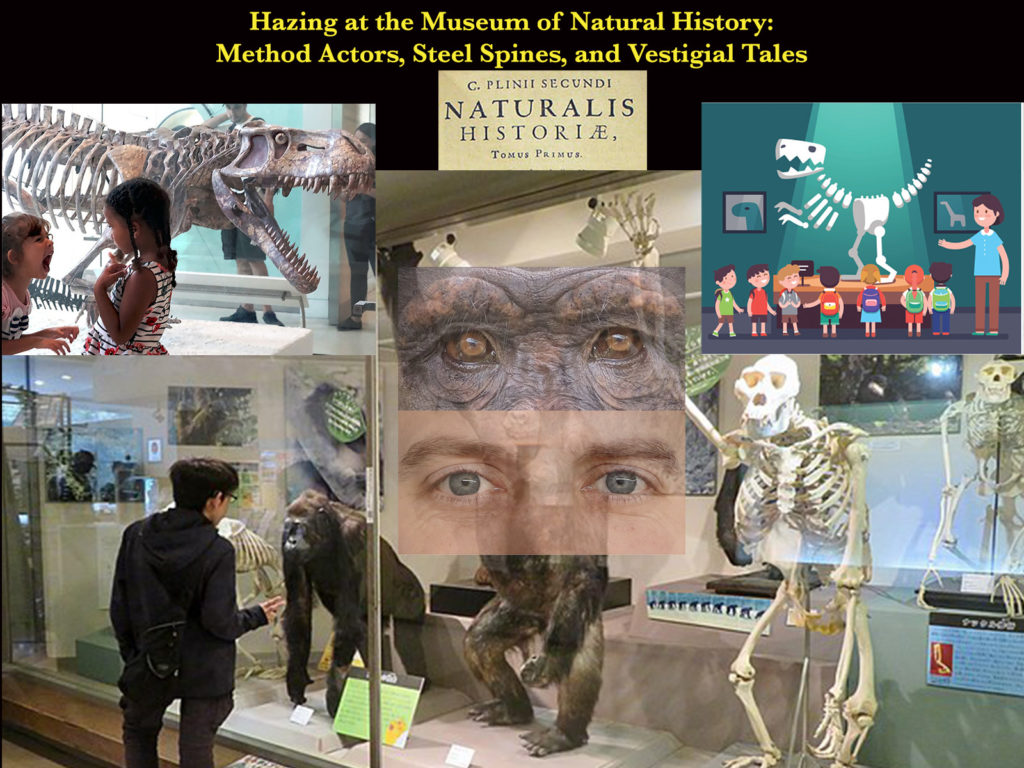
(adapted from Chapter 3 of The Door-Man)
I often take my grandkids to the American Museum of Natural History*. On Sundays. They have a blast; I suffer the collateral damage.
Looking into the eyes of another living person is surely a perilous affair, but too much time spent staring into the abysmal depths of the two marbles lodged in the pensive face of Pan Troglodytes – the stuffed chimpanzee in the Hall of Primates – is equally challenging. Worse still is trying to stare down the impassive gaze of the Inuit ‘Eskimo’ in the Hall of Human Origins – the tall fellow that looks both at you and through you. It’s hard enough even if you don’t know that the skull is actually real, pinned to a steel alloy spine wrapped in sealskin and Caribou hide.
But it only gets worse if you look behind the curtains,…er, the dioramas. It’s like high school back there – hazing in the science club: I know you are, but what am I?
I think it’s a food chain thing.
The Paleontologists are snobs. They look down their noses on the Anthropologists for navel‑gazing on humankind without appreciating the clock-hands of “deep time” or the evolutionary contributions of other navels to their own.
The Anthropologists are fussbudgets. Even when they do look back in Geological Time to their swamp-dwelling ichthyic ancestors, factions in their own ranks break out in a dust-up over whether human behavior evolved in the way that boney brainpans do, or whether we just make up our shenanigans as we go along.
The Zoology Department has body shaming issues. The poor folks in Invertebrate Zoology get it the worst – tongue worms, insects, arachnids, horseshoe crabs,…exoskeletons of cockroach chitin – ugh, no back bones. These are the kind of creatures that the folks in Vertebrate Zoology like to step on.
Plant life doesn’t fare much better. The Garden Club – Botanist, Protists and Fungi specialists tend to loiter at the vegetable trays in the Museum’s cafeteria. They’re easy to spot. It’s not just their inscrutable chit‑chat about spores at the nearby table, it’s more the humus under the fingernails. As bad as car mechanics.
And the Archaea and Bacteria folks? They know to pack their lunches and stick to the climate-controlled yeast tubs in the basement, monitoring the feasting of aboriginal bacterial hordes on dead tissue. One rarely lays eyes on them; and their own eyes rarely leave their microscopes.
The Astrophysicists are the only ones who seem to get it. They’re a breed apart; happy being stardust and looking for Life on another planet. The Earth?…been there, done that.
This is what happens, I suppose, when one spends too much time in the company of dead matter – when Life becomes “specimen,” mortal flesh tanned and stretched on armatures of bones bolted to metal, the kinship of Man and Beast laid out behind glass, and their habitats embalmed in shellac, resin, and rubber latex.
Perhaps I’m being unfair. That it’s all just good science at the Museum – you know, “The Method” and all – cutting things up at the joints so the grandkids and I can get a closer look.
And besides, the kids really do seem to enjoy the Museum. Really. They get a kick out of seeing their habitat arrayed in bits and pieces and their evolutionary cousins showcased in vitrines; in fact, the less their fellow creatures look like them – in size, number of limbs, disposition of body parts, or mode of travel – flit, slither, or crawl – the happier they are to press their sweet little faces to the glass and laugh at their reflections in the Mirror of Nature.
Me? I get an uncomfortable twinge in my vestigial tail.
*See an earlier Rumination for the fate of the AMNH statue out front: Shape-Shifting at the Museum of Natural History: Rough Writers, The timeliness of Cymbals, and Bad Homophones
Return to Ruminations







